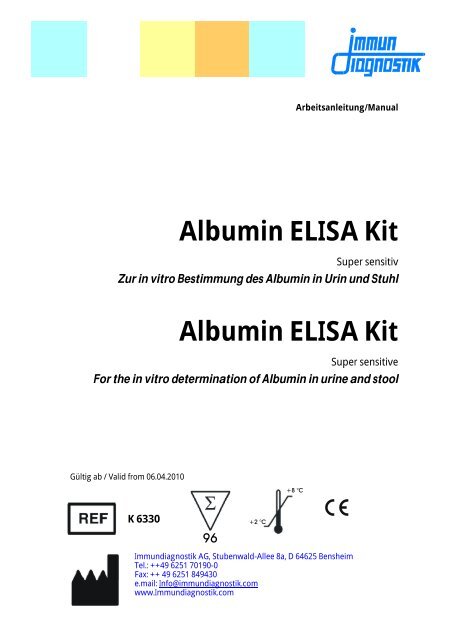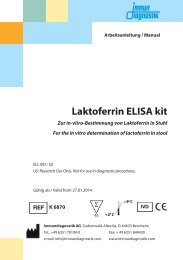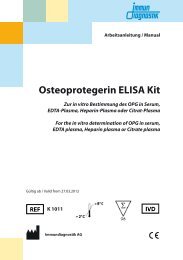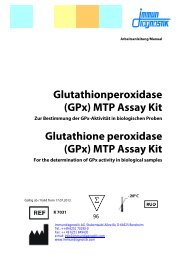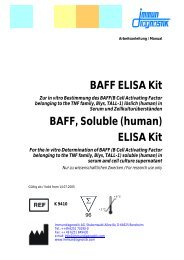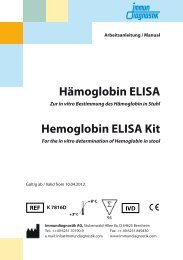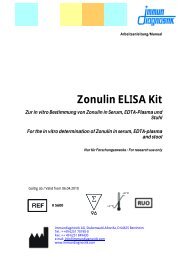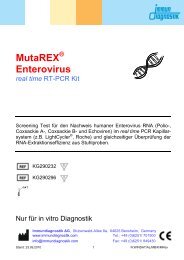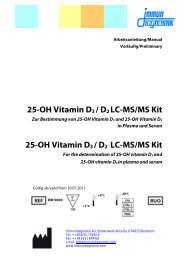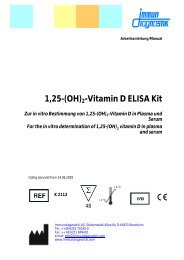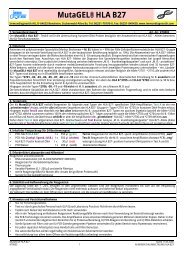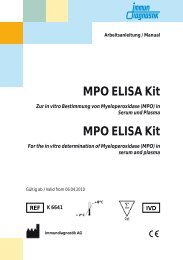Arbeitsanleitung/Manual Albumin - bei Immundiagnostik
Arbeitsanleitung/Manual Albumin - bei Immundiagnostik
Arbeitsanleitung/Manual Albumin - bei Immundiagnostik
Create successful ePaper yourself
Turn your PDF publications into a flip-book with our unique Google optimized e-Paper software.
96<br />
+2 °C<br />
+8 °C<br />
<strong>Ar<strong>bei</strong>tsanleitung</strong>/<strong>Manual</strong><br />
<strong>Albumin</strong> ELISA Kit<br />
Super sensitiv<br />
Zur in vitro Bestimmung des <strong>Albumin</strong> in Urin und Stuhl<br />
<strong>Albumin</strong> ELISA Kit<br />
Super sensitive<br />
For the in vitro determination of <strong>Albumin</strong> in urine and stool<br />
Gültig ab / Valid from 06.04.2010<br />
K 6330<br />
<strong>Immundiagnostik</strong> AG, Stubenwald-Allee 8a, D 64625 Bensheim<br />
Tel.: ++49 6251 70190-0<br />
Fax: ++ 49 6251 849430<br />
e.mail: Info@immundiagnostik.com<br />
www.<strong>Immundiagnostik</strong>.com
<strong>Ar<strong>bei</strong>tsanleitung</strong>/<strong>Manual</strong> <strong>Albumin</strong><br />
Inhaltsverzeichnis Seite/Page<br />
Table of content 2<br />
ALBUMIN ELISA KIT 1<br />
1. VERWENDUNGSZWECK 3<br />
2. EINLEITUNG 3<br />
3. TESTPRINZIP 3<br />
4. INHALT DER TESTPACKUNG 4<br />
5. ERFORDERLICHE LABORGERÄTE UND HILFSMITTEL 4<br />
6. VORBEREITUNG UND LAGERUNG DER REAGENZIEN 5<br />
7. HINWEISE UND VORSICHTSMASSNAHMEN 6<br />
8. PROBENVORBEREITUNG 6<br />
9. TESTDURCHFÜHRUNG 7<br />
HINWEISE 7<br />
PIPETTIERSCHEMA 8<br />
10. ERGEBNISSE 9<br />
MUSTEREICHKURVE 9<br />
11. EINSCHRÄNKUNGEN 10<br />
12. QUALITÄTSKONTROLLE 10<br />
ERWARTETE ERGEBNISSE 10<br />
13. TESTCHARAKTERISTIKA 11<br />
PRÄZISION UND REPRODUZIERBARKEIT 11<br />
SENSITIVITÄT 11<br />
KREUZREAKTIVITÄT 11<br />
14. LITERATUR 11<br />
15. ALLGEMEINE HINWEISE ZUM TEST 12<br />
1
<strong>Ar<strong>bei</strong>tsanleitung</strong>/<strong>Manual</strong> <strong>Albumin</strong><br />
Table of content Page<br />
1. INTENDED USE 15<br />
2. SUMMARY AND EXPLANATION OF THE TEST 15<br />
3. PRINCIPLE OF THE TEST 15<br />
4. MATERIAL SUPPLIED 16<br />
5. MATERIAL REQUIRED BUT NOT SUPPLIED 16<br />
6. PREPARATION AND STORAGE OF REAGENTS 17<br />
7. PRECAUTIONS 18<br />
8. SPECIMEN COLLECTION AND PREPARATION 18<br />
9. ASSAY PROCEDURE 19<br />
PROCEDURAL NOTES 19<br />
TEST PROCEDURE 19<br />
10. RESULTS 20<br />
TYPICAL CALIBRATION CURVE 20<br />
11. LIMITATIONS 21<br />
12. QUALITY CONTROL 21<br />
EXPECTED VALUES 21<br />
13. PERFORMANCE CHARACTERISTICS 22<br />
PRECISION AND REPRODUCIBILITY 22<br />
SENSITIVITY 22<br />
14. REFERENCES 22<br />
15. GENERAL NOTES ON THE TEST AND TEST PROCEDURE 23<br />
2
<strong>Ar<strong>bei</strong>tsanleitung</strong>/<strong>Manual</strong> <strong>Albumin</strong><br />
1. VERWENDUNGSZWECK<br />
Der hier beschriebene Assay ist für die Bestimmung von <strong>Albumin</strong> aus Urin<br />
und Stuhl geeignet. Nur zur in vitro Diagnostik.<br />
2. EINLEITUNG<br />
Veränderungen der <strong>Albumin</strong>konzentration im Urin und Stuhl sind im<br />
Wesentlichen eine Folge von Verteilungsstörungen, weniger von Synthesestörungen.<br />
Bei Nahrungsentzug fällt die Konzentration frühestens nach<br />
einer Woche unter den unteren Referenzbereichswert. Bei Proteinmangelernährung<br />
korreliert das Ausmaß der Ödeme nur schwach mit der <strong>Albumin</strong>konzentration.<br />
Stärkerer <strong>Albumin</strong>verlust nach außen, z.B. <strong>bei</strong>m<br />
nephrotischen Syndrom, führt zur gesteigerten Synthese.<br />
Erhöhte <strong>Albumin</strong>- wie auch Hämoglobinkonzentrationen im Stuhl werden<br />
nicht nur <strong>bei</strong> kolorektalen Karzinomen, sondern auch <strong>bei</strong> Polypen und<br />
chronisch-entzündlichen<br />
Ulcerosa) beobachtet.<br />
Indikation<br />
Darmerkrankungen (Morbus Crohn, Colitis<br />
• Nachweis von Blutungsquellen im unteren Gastrointestinaltrakt<br />
• Erkennung kolorektaler Karzinome<br />
• Untersuchung von Risikogruppen<br />
• Morbus Crohn, Colitis Ulcerosa<br />
3. TESTPRINZIP<br />
Der vorliegende Enzyme-Linked-Immuno-Sorbent-Assay (ELISA) dient zur<br />
quantitativen Erfassung des humanen <strong>Albumin</strong>s (h <strong>Albumin</strong>) aus Urin und<br />
Stuhl.<br />
Das humane <strong>Albumin</strong> aus den Proben wird in einem einstündigen<br />
Inkubationsschritt an die auf der Mikrotiterplatte immobilisierten<br />
polyklonalen anti-human <strong>Albumin</strong> Antikörper gebunden. Die Quantifizierung<br />
des gebundenen humanen <strong>Albumin</strong>s erfolgt nach einem Waschvorgang<br />
durch Zugabe eines Peroxidase-markierten Antikörpers, der sich<br />
ebenfalls an das humane <strong>Albumin</strong> bindet. Als Substrat für die Peroxidase<br />
wird Tetramethylbenzidin (TMB) verwendet. Die Substratumsetzung ist<br />
direkt proportional zum gebundenen human <strong>Albumin</strong> und kann<br />
photometrisch <strong>bei</strong> 450 nm gemessen werden.<br />
3
<strong>Ar<strong>bei</strong>tsanleitung</strong>/<strong>Manual</strong> <strong>Albumin</strong><br />
4. INHALT DER TESTPACKUNG<br />
Artikel Nr. Inhalt Kit Komponenten Menge<br />
K 6330MTP PLATE Mikrotiterplatte, vorbeschichtet 96<br />
K 6330WP WASHBUF ELISA Waschpufferkonzentrat 10x 1 x 100 ml<br />
K 6330PV SAMPLEBUF<br />
K6330VP CONJBUF<br />
K 6330K CONJ<br />
K 6330ST STD<br />
Probenverdünnungspuffer,<br />
gebrauchsfertig<br />
Konjugat Verdünnungspuffer,<br />
gebrauchsfertig<br />
Konjugat, (Kaninchen anti <strong>Albumin</strong>,<br />
Peroxidase-markiert)<br />
Standards, lyophilisiert<br />
(0; 12.5; 50; 200; 800 ng/ml)<br />
4<br />
1 x 100 ml<br />
1 x 15 ml<br />
1 x 50 µl<br />
4 x 5 vials<br />
K 6330KO1 CTRL Kontrolle, lyophilisiert 4 x 1 vial<br />
K 6330KO2 CTRL Kontrolle, lyophilisiert 4 x 1 vial<br />
K 6330TMB SUB<br />
TMB Substrat (Tetramethylbenzidin),<br />
gebrauchsfertig<br />
1 x 15 ml<br />
K 6330AC STOP ELISA Stopplösung, gebrauchsfertig 1 x 15 ml<br />
5. ERFORDERLICHE LABORGERÄTE UND HILFSMITTEL<br />
• Bidestilliertes Wasser (aqua bidest.)<br />
• Laborwaage<br />
• Präzisionspipetten und Pipettenspitzen für den Einmalgebrauch mit<br />
variablen Volumina von 10 - 1000 µl<br />
• Folie zum Abkleben der Mikrotiterplatte<br />
• Mikrotiterplattenschüttler<br />
• Multikanal- bzw. Multipipette<br />
• Zentrifuge, 3000 x g<br />
• Vortex-Mixer<br />
• Laborübliche Glas- oder Plastikröhrchen (Einmalartikel)<br />
• Mikrotiterplattenphotometer mit Filter 450 nm<br />
(Referenzfilter 620 oder 690 nm)
<strong>Ar<strong>bei</strong>tsanleitung</strong>/<strong>Manual</strong> <strong>Albumin</strong><br />
6. VORBEREITUNG UND LAGERUNG DER REAGENZIEN<br />
• Bitte achten Sie <strong>bei</strong> mehrfachem Einsatz der Platte darauf, dass die<br />
Reagenzien, wie in der Vorschrift beschrieben, gelagert und nur die für<br />
den jeweiligen Ansatz benötigten Reagenzienmengen frisch<br />
angesetzt werden. Der Kit kann so bis zu 4 x je nach Probenaufkommen<br />
bis zum angegebenen Haltbarkeitsdatum verwendet werden.<br />
• Reagenzien mit einem Volumen kleiner 100 µl sollten vor Gebrauch<br />
kurz anzentrifugiert werden, um Volumenverluste zu vermeiden.<br />
• Der WASHBUF (Waschpufferkonzentrat) muss vor Gebrauch 1:10 in<br />
aqua bidest. verdünnt werden (100 ml WASHBUF + 900 ml aqua bidest).<br />
Aufgrund der hohen Salzkonzentration in den Konzentraten kann es zu<br />
Kristallbildungen kommen. Die Kristalle lösen sich <strong>bei</strong> 37° C im<br />
Wasserbad auf. Das WASHBUF (Waschpufferkonzentrat) kann <strong>bei</strong> 2-8°C<br />
bis zum angegebenen Haltbarkeitsdatum aufbewahrt werden. Die<br />
verdünnte Pufferlösung ist <strong>bei</strong> 2-8 °C 1 Monat in einem geschlossenen<br />
Gefäß haltbar.<br />
• Die lyophilisierten STD (Standards) und CTRL (Kontrollen) sind <strong>bei</strong> 2-8°C<br />
bis zum angegebenen Haltbarkeitsdatum verwendbar. STD (Standards)<br />
und CTRL (Kontrollen) werden mit 500 µl aqua bidest. rekonstituiert,<br />
vorsichtig gemischt und zum Lösen mind. 10 Minuten stehen gelassen.<br />
Die rekonstituierten Standards und Kontrollen sind nicht stabil.<br />
• Das CONJ (Konjugat, POD–markierter AK) wird 1:400 in CONJBUF<br />
(Konjugatpuffer) verdünnt (z.B. 25 µl CONJ + 10 ml CONJBUF). Das CONJ<br />
(Konjugat) ist <strong>bei</strong> 2-8°C bis zum angegebenen Haltbarkeitsdatum stabil.<br />
Die verdünnte Konjugatlösung kann nicht aufbewahrt werden.<br />
• Alle anderen Testreagenzien sind <strong>bei</strong> 2-8 °C zu lagern und <strong>bei</strong><br />
entsprechender Lagerung bis zum angegebenen Verfallsdatum (siehe<br />
Etikett) verwendbar.<br />
5
<strong>Ar<strong>bei</strong>tsanleitung</strong>/<strong>Manual</strong> <strong>Albumin</strong><br />
7. HINWEISE UND VORSICHTSMASSNAHMEN<br />
• Nur zur in vitro Diagnostik.<br />
• Standards und Kontrollen sind auf Humanserum aufgebaut. Sie sind auf<br />
HIV und Hepatitis B getestet und für negativ befunden worden. Jedoch<br />
sollten die Testkomponenten als Vorsichtsmaßnahme immer wie<br />
potentiell infektiöses Material behandelt werden.<br />
• Die Stopplösung besteht aus verdünnter H2SO4. H2SO4 ist eine starke<br />
Säure und muss auch im verdünnten Zustand mit Vorsicht behandelt<br />
werden. H2SO4 verursacht <strong>bei</strong> Kontakt mit der Haut Verätzungen. Es<br />
sollte daher mit Schutzhandschuhen und Schutzbrille gear<strong>bei</strong>tet<br />
werden. Bei Kontakt mit der Säure muss die verätzte Stelle sofort mit viel<br />
Wasser gespült werden.<br />
• Die Reagenzien dürfen nach Ablauf des Mindesthaltbarkeitsdatums<br />
nicht mehr verwendet werden.<br />
8. PROBENVORBEREITUNG<br />
Urin<br />
Zur Lagerung sind die Urine mit 1 N NaOH auf einen pH-Wert zwischen 6<br />
und 8 einzustellen. Die Proben können bis zu zwei Wochen <strong>bei</strong> 2-8 °C<br />
gelagert werden. Bei längerer Lagerung müssen die Proben <strong>bei</strong> -20 °C<br />
aufbewahrt werden.<br />
Proben 1:200 mit SAMPLEBUF (Probenverdünnungspuffer) verdünnen,<br />
z.B. 10 µl Probe + 1990 µl SAMPLEBUF (Probenverdünnungspuffer).<br />
Stuhlproben<br />
Ca. 100 mg Stuhl einwiegen, die genau eingewogene Stuhlmenge notieren,<br />
in 5 ml Waschpuffer lösen und anschließend sehr gut mischen.<br />
Anschließend die Suspension für 10 Minuten <strong>bei</strong> 3000 rpm zentrifugieren.<br />
Danach den Überstand 1:5 mit SAMPLEBUF (Probenverdünnungspuffer)<br />
weiter verdünnen (z.B. 200 µl Überstand + 800 µl SAMPLEBUF).<br />
Aus diesen Einzelverdünnungen resultiert eine Endverdünnung von 1:250.<br />
Von dieser Endverdünnung 100 µl pro Vertiefung in den Test einsetzen. Wir<br />
empfehlen den Stuhl für jede Messung frisch einzuwiegen. Stuhlsuspensionen<br />
können nicht gelagert werden.<br />
6
<strong>Ar<strong>bei</strong>tsanleitung</strong>/<strong>Manual</strong> <strong>Albumin</strong><br />
Stuhlproben können <strong>bei</strong> –20°C 4 Wochen gelagert werden. Mehrfaches<br />
Einfrieren und Auftauen ist zu vermeiden.<br />
Zur einfacheren Dosierung und Homogenisierung des Probenmaterials<br />
empfehlen wir das Probenvorbereitungssystem der Fa. Roche Diagnostics /<br />
Mannheim (Best. Nr. 745804).<br />
9. TESTDURCHFÜHRUNG<br />
Hinweise<br />
• Reagenzien der Testpackung dürfen nicht mit anderen Chargen gemischt<br />
werden.<br />
• Qualitätskontrollen sollten immer mitgemessen werden.<br />
• Inkubationszeit, Temperatur und Pipettiervolumina sind vom Hersteller<br />
festgelegt. Jegliche Abweichung der Testvorschrift, die nicht mit dem<br />
Hersteller koordiniert wurde, kann zu fehlerhaften Ergebnissen führen.<br />
<strong>Immundiagnostik</strong> übernimmt keine Haftung.<br />
• Die Reagenzien dürfen nach Ablauf des Mindesthaltbarkeitsdatums nicht<br />
mehr verwendet werden.<br />
7
<strong>Ar<strong>bei</strong>tsanleitung</strong>/<strong>Manual</strong> <strong>Albumin</strong><br />
Pipettierschema<br />
Die PLATE (vorbeschichtete Mikrotiterplatte) vor Gebrauch 5 x mit je<br />
250 µl verdünntem Waschpuffer waschen. Mikrotiterplatte nach dem<br />
letzten Waschgang auf Saugpapier ausschlagen um die Waschpufferreste<br />
vollständig zu entfernen. Dies gilt für alle folgenden Waschschritte.<br />
Die Bestimmungen sind in der Mikrotiterplatte in Doppelwerten<br />
durchzuführen.<br />
1. 100 µl STD (Standard), CTRL (Kontrollen) und Patientenproben pro<br />
Vertiefung in Doppelbestimmungen pipettieren.<br />
2. 1 Stunde <strong>bei</strong> Raumtemperatur unter Schütteln auf Horizontalmischer<br />
inkubieren.<br />
3. Den Inhalt der Wells verwerfen und 5 x mit je 250 µl verdünntem<br />
Waschpuffer waschen. Mikrotiterplatte nach dem letzten Waschgang<br />
auf Saugpapier ausschlagen.<br />
4. 100 µl CONJ (Konjugat) pro Vertiefung pipettieren.<br />
5. 1 Stunde <strong>bei</strong> Raumtemperatur unter Schütteln inkubieren.<br />
6. Den Inhalt der Wells verwerfen und 5 x mit je 250 µl verdünntem<br />
Waschpuffer waschen. Mikrotiterplatte nach dem letzten Waschgang<br />
auf Saugpapier ausschlagen.<br />
7. 100 µl SUB (TMB-Substrat) pro Vertiefung pipettieren.<br />
8. 10-20 Minuten <strong>bei</strong> Raumtemperatur inkubieren bis eine ausreichend<br />
große Farbdifferenz auftritt.<br />
9. 50 µl STOP (Stopplösung) in jede Vertiefung pipettieren.<br />
10. Die Extinktion sofort im Mikrotiterplattenphotometer <strong>bei</strong> 450 nm<br />
gegen die Referenzwellenlänge 620 nm (oder 690 nm) messen. Sollte<br />
die Extinktion des höchsten Standards den Messbereich des<br />
Photometers übersteigen, sollte sofort <strong>bei</strong> 405 nm gegen 620 nm<br />
(690 nm) gemessen werden.<br />
8
<strong>Ar<strong>bei</strong>tsanleitung</strong>/<strong>Manual</strong> <strong>Albumin</strong><br />
10. ERGEBNISSE<br />
Zur Auswertung des Testes empfehlen wir die 4-Parameter-Funktion.<br />
Alternativ kann auch eine Punkt-zu-Punkt-Auswertung oder eine<br />
gewichtete Spline-Funktion gewählt werden. Vor jeder automatischen<br />
Auswertung sollte stets eine Kontrolle der Doppelwerte auf Plausibilität<br />
(„Ausreißerkontrolle“) durchgeführt werden; falls dies nicht durch das<br />
verwendete Programm erfolgt, sollte diese der Operator durchführen.<br />
Mustereichkurve<br />
Konzentration [ng/ml] 800 200 50 12.5 0<br />
OD Mittelwert 1.353 1.114 0.687 0.269 0.118<br />
Die hier aufgeführten Ergebnisse sind ein Beispiel für eine Standardkurve.<br />
Sie dürfen nicht für die Auswertung des Assays verwendet werden.<br />
9
<strong>Ar<strong>bei</strong>tsanleitung</strong>/<strong>Manual</strong> <strong>Albumin</strong><br />
Stuhlproben<br />
Die ermittelte <strong>Albumin</strong>konzentration der Stuhlprobe wird wie im folgenden<br />
Beispiel berechnet:<br />
Einwaage: 80 mg (1ml Stuhl = 1g) = 0,08 ml<br />
Verdünnungsstufe 1: 5ml / 0,08ml = 62,5<br />
Verdünnungsstufe 2: 5<br />
Verdünnungsfaktor: 312,5<br />
Die ermittelte <strong>Albumin</strong>konzentration der Stuhlprobe wird mit 312.5<br />
multipliziert, um die tatsächliche Konzentration zu bestimmen. Der Faktor<br />
ändert sich mit der Einwaage der Stuhlprobe.<br />
Urin<br />
Der ermittelte <strong>Albumin</strong>wert wird mit 200 multipliziert um die tatsächliche<br />
Konzentration zu bestimmen.<br />
11. EINSCHRÄNKUNGEN<br />
Proben mit einer <strong>Albumin</strong>konzentration größer dem größten Standard<br />
sollten stärker verdünnt und nochmals im Assay eingesetzt werden.<br />
12. QUALITÄTSKONTROLLE<br />
Wir empfehlen <strong>bei</strong> jedem Testansatz Kontrollen mitzumessen. Die<br />
Ergebnisse der Kontrollen müssen auf Richtigkeit überprüft werden. Liegen<br />
eine oder mehrere Kontrollen außerhalb des angegebenen Bereiches kann<br />
<strong>Immundiagnostik</strong> die Richtigkeit der Proben nicht gewährleisten.<br />
Erwartete Ergebnisse<br />
Normwerte<br />
Stuhl : < 9.2 mg/l (n = 76)<br />
Urin: 5 – 16 mg/l<br />
Wir empfehlen jedem Labor einen eigenen Normwertbereich zu etablieren.<br />
10
<strong>Ar<strong>bei</strong>tsanleitung</strong>/<strong>Manual</strong> <strong>Albumin</strong><br />
13. TESTCHARAKTERISTIKA<br />
Präzision und Reproduzierbarkeit<br />
Intra-Assay-Variation<br />
Die Reproduzierbarkeit von einer Probe innerhalb einer Messserie wurde<br />
geprüft.<br />
Intra-Assay VK n= 20<br />
Probe<br />
Inter-Assay-Variation<br />
<strong>Albumin</strong><br />
[mg/l]<br />
11<br />
Intra-Assay Vk<br />
[%]<br />
1 50 5<br />
Die Reproduzierbarkeit von einer Probe an unterschiedlichen Tagen wurde<br />
geprüft.<br />
Inter-Assay VK n= 20<br />
Sensitivität<br />
Probe<br />
<strong>Albumin</strong><br />
[mg/l]<br />
Inter-Assay Vk<br />
[%]<br />
1 50 8<br />
Die Nachweisgrenze wurde festgelegt als B0 + 2 SD. Gemessen wurde 20mal<br />
der Standard null. Die Messungen ergaben eine Nachweisgrenze von<br />
12.5 ng/ml.<br />
Kreuzreaktivität<br />
Es wurde keine Kreuzreaktivität zu anderen Plasmaproteinen im Stuhl<br />
gefunden.<br />
14. LITERATUR<br />
1. Trasch und Bloch 1993; Klin. Lab.39, 479-484<br />
2. John et al., 1994; Klin.Lab. 40, 77-81
<strong>Ar<strong>bei</strong>tsanleitung</strong>/<strong>Manual</strong> <strong>Albumin</strong><br />
15. ALLGEMEINE HINWEISE ZUM TEST<br />
• Dieser Kit wurde nach der IVD Richtlinie 98/79/EG hergestellt und in<br />
den Verkehr gebracht.<br />
• Nur zur in vitro Diagnostik.<br />
• Für die Qualitätskontrolle sind die für medizinische Laboratorien<br />
erstellten Richtlinien zu beachten.<br />
• Das für Kitkomponenten verwendete humane Material wurde auf HIV,<br />
Hepatitis B und Hepatitis C getestet und für negativ befundet. Dennoch<br />
wird empfohlen, die Kitkomponenten als Vorsichtsmaßnahme immer<br />
wie potentiell infektiöses Material zu behandeln.<br />
• Die Testkomponenten enthalten zum Schutz vor bakteriellen<br />
Kontaminationen Natriumazid oder Thimerosal. Natriumazid/<br />
Thimerosal sind giftig. Substrate für enzymatische Farbreaktionen sind<br />
als giftig und karzinogen beschrieben. Jeder Kontakt mit der Haut oder<br />
der Schleimhaut ist zu vermeiden.<br />
• Einzelkomponenten verschiedener Chargen dürfen nicht gemischt<br />
oder ausgetauscht werden.<br />
• Die Reagenzien dürfen nach Ablauf des auf der Verpackung<br />
angegebenen Datums nicht mehr verwendet werden.<br />
• Die charakteristischen Testdaten wie Inkubationszeiten, Inkubationstemperaturen<br />
und Pipettiervolumina der verschiedenen Komponenten<br />
wurden firmenintern festgelegt. Nicht mit dem Hersteller<br />
abgesprochene Veränderungen in der Testdurchführung können die<br />
Resultate beeinflussen. Die Firma <strong>Immundiagnostik</strong> übernimmt für die<br />
hierdurch entstandenen Schäden und Folgeschäden keine Haftung.<br />
• Bei Gewährleistungsansprüchen ist das beanstandete Material mit<br />
schriftlicher Erklärung innerhalb von 14 Tagen zum Hersteller - der<br />
<strong>Immundiagnostik</strong> zurück zu senden.<br />
12
<strong>Ar<strong>bei</strong>tsanleitung</strong>/<strong>Manual</strong> <strong>Albumin</strong><br />
13
<strong>Ar<strong>bei</strong>tsanleitung</strong>/<strong>Manual</strong> <strong>Albumin</strong><br />
14<br />
96<br />
+2 °C<br />
+8 °C<br />
<strong>Manual</strong><br />
<strong>Albumin</strong> ELISA Kit<br />
Super sensitive<br />
For the in vitro determination of <strong>Albumin</strong> in urine and stool<br />
Valid from 06.04.2010<br />
K6330<br />
<strong>Immundiagnostik</strong> AG, Stubenwald-Allee 8a, D 64625 Bensheim<br />
Tel.: ++49 6251 70190-0<br />
Fax: ++ 49 6251 849430<br />
e.mail: Info@immundiagnostik.com<br />
www.<strong>Immundiagnostik</strong>.com
<strong>Ar<strong>bei</strong>tsanleitung</strong>/<strong>Manual</strong> <strong>Albumin</strong><br />
1. INTENDED USE<br />
The <strong>Immundiagnostik</strong> Assay is intended for the quantitative determination<br />
of <strong>Albumin</strong> in urine and stool. For in vitro diagnostic use only.<br />
2. SUMMARY AND EXPLANATION OF THE TEST<br />
<strong>Albumin</strong> is the major protein in human plasma (40-60%). It is synthesized in<br />
the liver depending of the protein uptake. <strong>Albumin</strong> in fecal samples refers to<br />
an inflammatory reaction combined with intestinal bleeding. Elevated levels<br />
of albumin and hemoglobin in stool are found not only by colorectal<br />
carcinomas, but also with polyps and during chronic inflammatory diseases<br />
(Morbus Crohn or Colitis Ulcerosa).<br />
Indication<br />
• Detection of source of bleeding in the lower gastrointestinal tract<br />
• Detection of colorectal carcinoma<br />
• Investigation of high risk patients<br />
• Morbus Crohn, Colitis Ulcerosa<br />
3. PRINCIPLE OF THE TEST<br />
This Enzyme-Linked Immunosorbent Assay (ELISA) is a two step assay for<br />
the ultra sensitive determination of human albumin in stool and urine. A<br />
polyclonal rabbit antibody specific for human albumin is immobilized on a<br />
microtiter plate and a second anti-albumin antibody is conjugated to<br />
peroxidase (POD).<br />
In a first incubation step, the albumin in the samples is bound to the<br />
immobilized anti-albumin antibodies. A washing step is carried out to<br />
remove all unbound substances. In a second incubation step, a POD-labeled<br />
anti-albumin antibody is added. After another washing step, to remove all<br />
unbound substances, a POD-substrate, tetramethylbenzidine (TMB), is<br />
added. The enzymatic reaction is terminated by an acidic stop solution,<br />
whereby the color converts from blue to yellow. The intensity of the yellow<br />
color is directly proportional to the concentration of albumin in the sample.<br />
A dose response curve of the absorbance unit (optical density, OD) vs.<br />
concentration is generated using the results obtained from the calibrators.<br />
<strong>Albumin</strong> in the patient samples is determined directly from this curve.<br />
15
<strong>Ar<strong>bei</strong>tsanleitung</strong>/<strong>Manual</strong> <strong>Albumin</strong><br />
4. MATERIAL SUPPLIED<br />
Cat. No Label Kit Components Quantity<br />
K 6330MTP PLATE Precoated strips 96<br />
K 6330WP WASHBUF ELISA wash buffer concentrate (10x) 1 x 100 ml<br />
K 6330PV SAMPLEBUF Sample dilution buffer, ready to use 1 x 100 ml<br />
K6330VP CONJBUF<br />
K 6330K CONJ<br />
K 6330ST STD<br />
Conjugate dilution buffer,<br />
ready-to-use<br />
Conjugate, (rabbit-anti-<strong>Albumin</strong><br />
peroxidase-labeled)<br />
Calibrators, lyophilized<br />
(0, 12.5, 50, 200, 800 µg/l)<br />
16<br />
1 x 15 ml<br />
1 x 50 µl<br />
4 x 5 vials<br />
K 6330KO1 CTRL Control, lyophilized 4 x 1 vial<br />
K 6330KO2 CTRL Control, lyophilized 4 x 1 vial<br />
K 6330TMB SUB<br />
TMB substrate (Tetramethylbenzidine),<br />
ready-to-use<br />
1 x 15 ml<br />
K 6330AC STOP ELISA stop solution, ready to use 1 x 15 ml<br />
5. MATERIAL REQUIRED BUT NOT SUPPLIED<br />
• Bidistilled (aqua bidest.) and sterile water<br />
• Laboratory balance<br />
• Precision pipettors calibrated and tips to deliver 5-1000 µl<br />
• Foil to cover the microtiter plate<br />
• Horizontal microtiter plate shaker<br />
• A multi-channel dispenser or repeating dispenser<br />
• Centrifuge capable of 3000 x g<br />
• Vortex-Mixer<br />
• Standard laboratory glass or plastic vials, cups, etc.<br />
• Microtiter plate reader at 450 or 405 nm<br />
(reference wave length 620 or 690 nm)
<strong>Ar<strong>bei</strong>tsanleitung</strong>/<strong>Manual</strong> <strong>Albumin</strong><br />
6. PREPARATION AND STORAGE OF REAGENTS<br />
• To run assay more than once, ensure that reagents are stored at<br />
conditions stated on the label. Prepare only the appropriate amount<br />
necessary for each assay. The kit can be used up to 4 times within the<br />
expiry date stated on the label.<br />
• Reagents with a volume less than 100 µl should be centrifuged before<br />
use to avoid loss of volume.<br />
• The WASHBUF (wash buffer concentrate) must be diluted with aqua<br />
bidest. 1:10 before use (100 ml WASHBUF + 900 ml aqua bidest.), mix<br />
well. Crystals could occur due to high salt concentration in the stock<br />
solutions. The crystals must be redissolved at 37°C using a water bath<br />
before dilution of the buffer solutions. The WASHBUF (wash buffer<br />
concentrate) is stable at 2-8°C until the expiry date stated on the label.<br />
Diluted buffer solution can be stored in a closed flask at 2-8°C for one<br />
month.<br />
• The lyophilized STD (calibrators) and the CTRL (controls) must be<br />
reconstituted with 500 µl aqua bidest. Allow the vial content to dissolve<br />
for 10 minutes and mix thoroughly by gentle inversion to insure<br />
complete reconstitution. Reconstituted Calibrators and Controls are<br />
not stable and can not be stored.<br />
• The CONJ (conjugate, POD-Antibody) must be diluted 1:400 in<br />
CONJBUF (conjugate dilution buffer, e.g. 25 µl CONJ + 10 ml CONJBUF).<br />
The CONJ (conjugate, POD-Antibody) is stable at 2 -8 °C until the expiry<br />
date given on the label. Diluted antibody is not stable and can not be<br />
stored.<br />
• All other test reagents are ready for use. The test reagents are stable up<br />
to the date of expiry (see label of test package) when stored at<br />
2-8°C.<br />
17
<strong>Ar<strong>bei</strong>tsanleitung</strong>/<strong>Manual</strong> <strong>Albumin</strong><br />
7. PRECAUTIONS<br />
• For in vitro diagnostic use only.<br />
• Human materials used in kit components were tested and found to be<br />
negative for HIV, Hepatitis B and Hepatitis C. However, for safety reasons,<br />
all kit components should be treated as potentially infectious.<br />
• Stop solution is composed of sulfuric acid, which is a strong acid. Even<br />
diluted, it still must be handled with care. It can cause acid burns and<br />
should be handled with gloves, eye protection, and appropriate<br />
protective clothing. Any spills should be wiped out immediately with<br />
copious quantities of water.<br />
• Reagents should not be used beyond the expiration date shown on the<br />
kit label.<br />
8. SPECIMEN COLLECTION AND PREPARATION<br />
Urine<br />
Adjust urine to a pH 6 to 8 with 1 N NaOH. Samples can be stored for two<br />
weeks at 2-8 °C or at -20°C for longtime storage.<br />
For the assay, dilute samples 1:200 with SAMPLEBUF (sample dilution<br />
buffer), e.g.<br />
10 µl sample +1990 µl SAMPLEBUF (sample dilution buffer).<br />
Faeces<br />
Add about 100 mg of the sample (note the sample weight for the<br />
calculation) to 5 ml of wash buffer and mix.<br />
Centrifuge the sample suspension for 10 min at 3000 rpm.<br />
Dilute supernatant 1:5 in SAMPLEBUF (sample dilution buffer; e.g.<br />
200 µl supernatant + 800 µl SAMPLEBUF). Use 100 µl of the obtained<br />
solution for the test.<br />
We recommend to weight fresh stool samples for each run. Supernatant is<br />
not stable and can not be stored.<br />
Stool samples can be stored at –20°C for 4 weeks. Avoid repeated freezing<br />
and thawing.<br />
<strong>Immundiagnostik</strong> recommends the use of tubes from Roche Diagnostics/<br />
Mannheim (No. 745804) for sample preparation.<br />
18
<strong>Ar<strong>bei</strong>tsanleitung</strong>/<strong>Manual</strong> <strong>Albumin</strong><br />
9. ASSAY PROCEDURE<br />
Procedural notes<br />
• Do not interchange different lot numbers of any kit component within<br />
the same assay.<br />
• Quality control guidelines should be observed.<br />
• Incubation time, incubation temperature and pipetting volumes of the<br />
components are defined by the producer. Any variation of the test<br />
procedure, which is not coordinated with the producer, may influence<br />
the results of the test. <strong>Immundiagnostik</strong> AG can therefore not be held<br />
responsible for any damage resulting from wrong use.<br />
• The assay should always be performed according the enclosed manual.<br />
Test procedure<br />
Wash the precoated PLATE (microtiter plate) 5 x with 250 µl diluted wash<br />
buffer. After the final washing step, the inverted PLATE should be firmly<br />
tapped on absorbent paper to remove excess solution. This is valid for all<br />
following washing steps. Carry out each determination in duplicate for<br />
standards, controls and samples.<br />
1. Add 100 µl STD (Standard), CTRL (Controls) and diluted patient<br />
samples into respective wells.<br />
2. Incubate for 1 hour shaking on a horizontal mixer at room<br />
temperature.<br />
3. Decant the content of the PLATE and wash the wells 5 x with 250µl<br />
diluted wash buffer.<br />
4. Add 100 µl diluted conjugate in each well.<br />
5. Incubate for 1 hour shaking on a horizontal mixer at room<br />
temperature.<br />
6. Decant the content of the PLATE and wash the wells 5 x with 250µl<br />
diluted wash buffer.<br />
7. Add 100 µl SUB (TMB substrate) in each well.<br />
8. Incubate for 10-20 minutes at room temperature.<br />
9. Add 50 µl STOP (stop solution) in each well and mix shortly.<br />
10. Determine absorption immediately with an ELISA reader at 450 nm<br />
against 620 nm (or 690 nm) as reference. If no reference wavelength is<br />
available, read only at 450 nm. If the extinction of the highest standard<br />
exceeds the measurement range of the photometer, absorption must<br />
be measured immediately at 405 nm against 620 nm (or 690 nm) as<br />
reference.<br />
19
<strong>Ar<strong>bei</strong>tsanleitung</strong>/<strong>Manual</strong> <strong>Albumin</strong><br />
10. RESULTS<br />
We recommend the 4-parameter-algorithm for evaluation of the test results.<br />
Alternatively, a point-to-point-calculation or a spline-algorithm can be used.<br />
Before the automatic evaluation of the results, the plausibility of the pairs of<br />
values should be examined. If this option is not available with the used<br />
program, a control of the paired values should be done manually.<br />
Typical calibration curve<br />
Concentration [ng/ml] 800 200 50 12.5 0<br />
OD mean values 1.353 1.114 0.687 0.269 0.118<br />
The data is for demonstration only and cannot be used for the evaluation of<br />
test results.<br />
20
<strong>Ar<strong>bei</strong>tsanleitung</strong>/<strong>Manual</strong> <strong>Albumin</strong><br />
Faeces<br />
For the <strong>Albumin</strong> concentration of faeces samples, calculate as described in<br />
the following example:<br />
Weight: 80 mg (1ml stool = 1g) = 0,08 ml<br />
Dilution step 1: 5ml / 0,08ml = 62,5<br />
Dilution step 2: 5<br />
Dilution factor: 312.5<br />
Multiply the result by 312.5 to get the concentration of the sample. The<br />
dilution factor depends on the weight of the faeces.<br />
Urine<br />
To get the <strong>Albumin</strong> concentration in urine samples the observed values<br />
must be multiplied by 200.<br />
11. LIMITATIONS<br />
Samples with <strong>Albumin</strong> levels greater than the highest calibrator should be<br />
further diluted and re-assayed.<br />
12. QUALITY CONTROL<br />
<strong>Immundiagnostik</strong> recommends commercial control samples for<br />
internal quality control.<br />
Control samples should be analyzed with each run. Results, generated from<br />
the analysis of control samples, should be evaluated for acceptability using<br />
appropriate statistical methods. The results for the patient samples may not<br />
be valid, if within the same assay one or more values of the quality control<br />
sample are outside the acceptable limits.<br />
Expected values<br />
Normal range<br />
<strong>Albumin</strong> in stool: < 9.2 mg/l (n = 76)<br />
<strong>Albumin</strong> in urine: 5 - 16 mg/l<br />
21
<strong>Ar<strong>bei</strong>tsanleitung</strong>/<strong>Manual</strong> <strong>Albumin</strong><br />
13. PERFORMANCE CHARACTERISTICS<br />
Precision and reproducibility<br />
Intra-Assay<br />
The precision (intra-assay variation) was calculated from 20 replicate<br />
determinations on one sample.<br />
Intra-Assay CV n=20<br />
Inter-Assay<br />
Sample<br />
<strong>Albumin</strong><br />
[mg/l]<br />
22<br />
Intra-Assay CV<br />
[%]<br />
1 50 5<br />
The total precision (inter-assay variation) of was calculated from data on one<br />
sample obtained in 20 different assays over a period of three months.<br />
Inter-Assay CV n = 20<br />
Sensitivity<br />
Sample<br />
<strong>Albumin</strong><br />
[mg/l]<br />
Inter-Assay CV<br />
[%]<br />
1 50 8<br />
The detection limit was set as B0 + 2 SD and estimated to be 12.5 ng/l. The<br />
Zero-standard was measured 20 times.<br />
Cross reactivity<br />
No cross reactivity to other plasma proteins in faeces.<br />
14. REFERENCES<br />
1. Trasch and Bloch: 1993; Clin. Lab. 39, 479-484<br />
2. John et al.: 1994; Clin. Lab. 40, 77-81
<strong>Ar<strong>bei</strong>tsanleitung</strong>/<strong>Manual</strong> <strong>Albumin</strong><br />
15. GENERAL NOTES ON THE TEST AND TEST PROCEDURE<br />
• This assay was produced and put on the market according to the IVD<br />
guidelines of 98/79/EC.<br />
• Human materials used in kit components were tested and found to be<br />
negative for HIV, Hepatitis B and Hepatitis C. However, for safety reasons,<br />
all kit components should be treated as potentially infectious.<br />
• Kit reagents contain sodium azide or thimerosal as bactericides. Sodium<br />
azide and thimerosal are toxic. Substrates for the enzymatic color<br />
reactions are toxic and carcinogenic. Avoid contact with skin or mucous<br />
membranes.<br />
• All reagents in the kit package are for in vitro diagnostic use only.<br />
• Guidelines for medical laboratories should be observed.<br />
• Reagents should not be used beyond the expiration date shown on the<br />
kit label.<br />
• Do not interchange different lot numbers of any kit component within<br />
the same assay.<br />
• The assay should always be performed according the enclosed manual.<br />
• Incubation time, incubation temperature and pipetting volumes of the<br />
components are defined by the producer. Any variation of the test<br />
procedure, which is not coordinated with the producer, may influence<br />
the results of the test. <strong>Immundiagnostik</strong> AG can therefore not be held<br />
responsible for any damage resulting from wrong use.<br />
• Warranty claims and complaints in respect of deficiencies must be<br />
logged within 14 days after receipt of the product. The product shall be<br />
send to <strong>Immundiagnostik</strong> AG along with a written complaint.<br />
23
<strong>Ar<strong>bei</strong>tsanleitung</strong>/<strong>Manual</strong> <strong>Albumin</strong><br />
24


